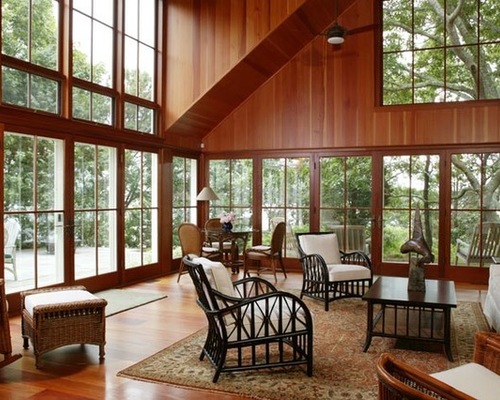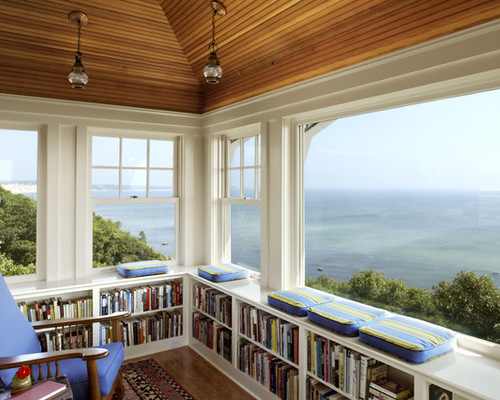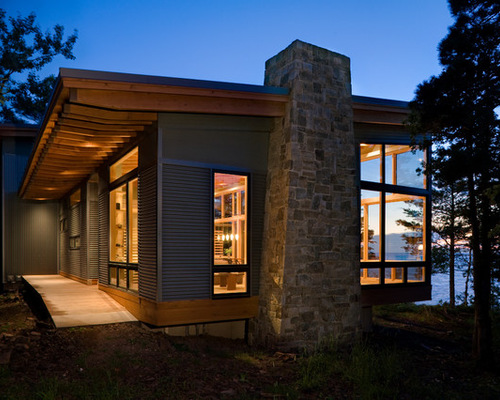The romantic allure of waterside living is undeniable, but back in America’s colonial times, no one wanted to live on or near the coast who could afford to live inland. The coast was fraught with danger — storms, flooding, disease and wind are more severe on the water than inland.
Those perils still exist but are managed today, and living by an ocean, lake or river has gone from scary to desirable.
Situated at the end of a peninsula on Martha’s Vineyard, Massachusetts, overlooking a tidal pond and harbor, this house originally turned its back on the water. Within the restrictions imposed on waterfront properties, the home was renovated to better fit its site. The addition is capped with a dramatic double-gabled roof, giving the home an expressive facade that addresses the water.
Design 101: How a Site Can Shape a Home


Frank Shirley Architects, original photo on Houzz
Managing the Risks of Life by the Water
Where you build still has a huge impact on what you build — no more so than when the forces of nature can threaten your home. Managing risk by the water means better building practices and adhering to stringent code requirements for new construction and major renovations of existing homes. Those codes mandate structural design standards, setbacks from water and site design limitations, all intended to minimize the impact of flooding on any coastal site and wind on an oceanfront.
Most regulations set maximums: how tall your house can be, how big your footprint can be, how many bedrooms you can have. But regulations that make it safer to live by the water require minimums — most classically a minimum height of a home’s lowest floor above where a high tide, flood level or tidal surge might get to.
Because all regulations focus on where the water is as a line on a site plan, and what level your land is, a survey is required to nail down what limitations are present on the site. An experienced local attorney could be necessary as well.
Find an Experienced Builder You Can Trust


Albert, Righter & Tittmann Architects, Inc., original photo on Houzz
Shaping the Solutions
Water shapes the aesthetics of nearby homes in several essential ways. Dimensional and structural requirements often require licensed engineers to determine what standards apply and then design to those standards. And architects can help in lofting a home to the required height.
The brutality of the weather at water sites means painted surfaces are not a good idea; the sun, wind and rain tend to erode any coating. So masonry, vinyl, natural wood shingles — and increasingly PVC — are often the default settings for exterior cladding.
Doors and windows that open and close by sliding simply do not seal as well as doors and windows that swing on hinges. Simple roof shapes that avoid valleys (folds in the roof between gables and dormers) resist water. Roof overhangs and porches shed the intense sun and drenching, wind-driven rain that often accompany waterside sites.
This cabin is on a wooded 3-acre site featuring the rocky shoreline of Lake Superior, a lake that sometimes behaves like the ocean. The 2,000-square-foot cabin cantilevers out toward the water, with a 40-foot-long glass wall facing the spectacular beauty of the lake.


FINNE Architects, original photo on Houzz
The exterior is clad in corrugated metal siding for maximum durability, with generous glass areas to provide natural lighting and ventilation, large overhangs for sun and snow protection, birch paneling and low-VOC paints.
The beauty of water is undeniable, but its dangers prevented our ancestors from valuing it — until technology made its dangers less daunting. And those technologies impact the designs of the homes that enjoy the allure of waterside living. A safe distance to the edge of the water is prescribed, and even the nature of the finished grading is reviewed and verified, so you do not direct water dangerously toward your neighbors. From foundations to the design requirements to resist high winds, water-focused home design plays by a whole separate rule book from its landed compatriots.
In high-wind-velocity areas, the actual type of glass can be prescribed. And in the most dangerously exposed areas (as determined by the Federal Emergency Management Agency), protections for all the doors and windows —such as shutters or plywood panels — could be installed when storms hit.
Even if you are living lightly by a marsh, far away from any windswept ocean or flooding river, the water on your site regulates things like where your septic system can be, how you can add onto your home and the level of your basement.
This new house in Cape Cod, Massachusetts, takes advantage of its water location with a long and narrow form, mostly one room deep, which allows all the major rooms to be open both to the northern water views and the southern sun. The spectacular view is framed with windows that respond to their coastal location: Both the glass windows and the structural supports between them are stronger than they would be in a landed location.
7 Steps to Building a New Home


